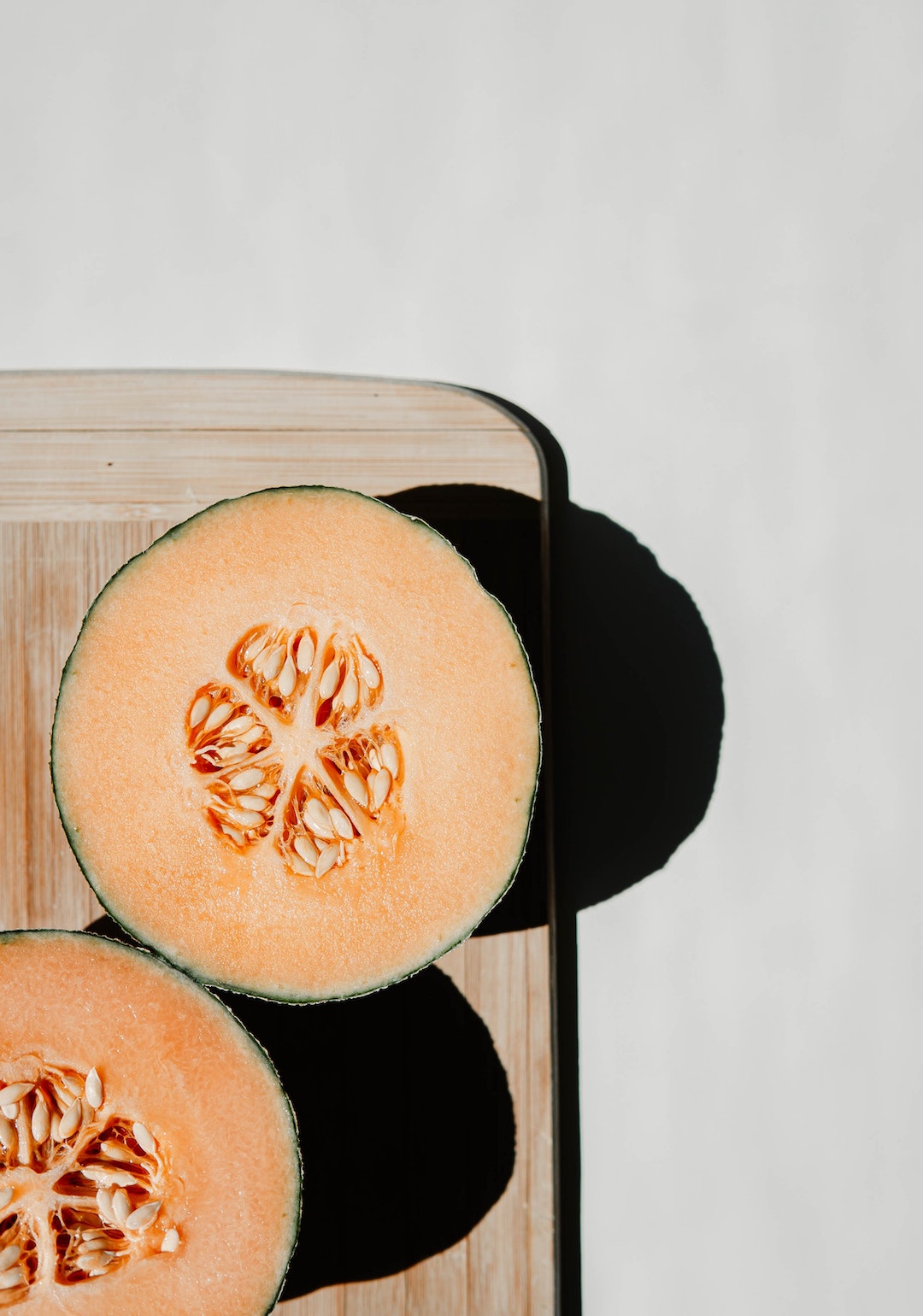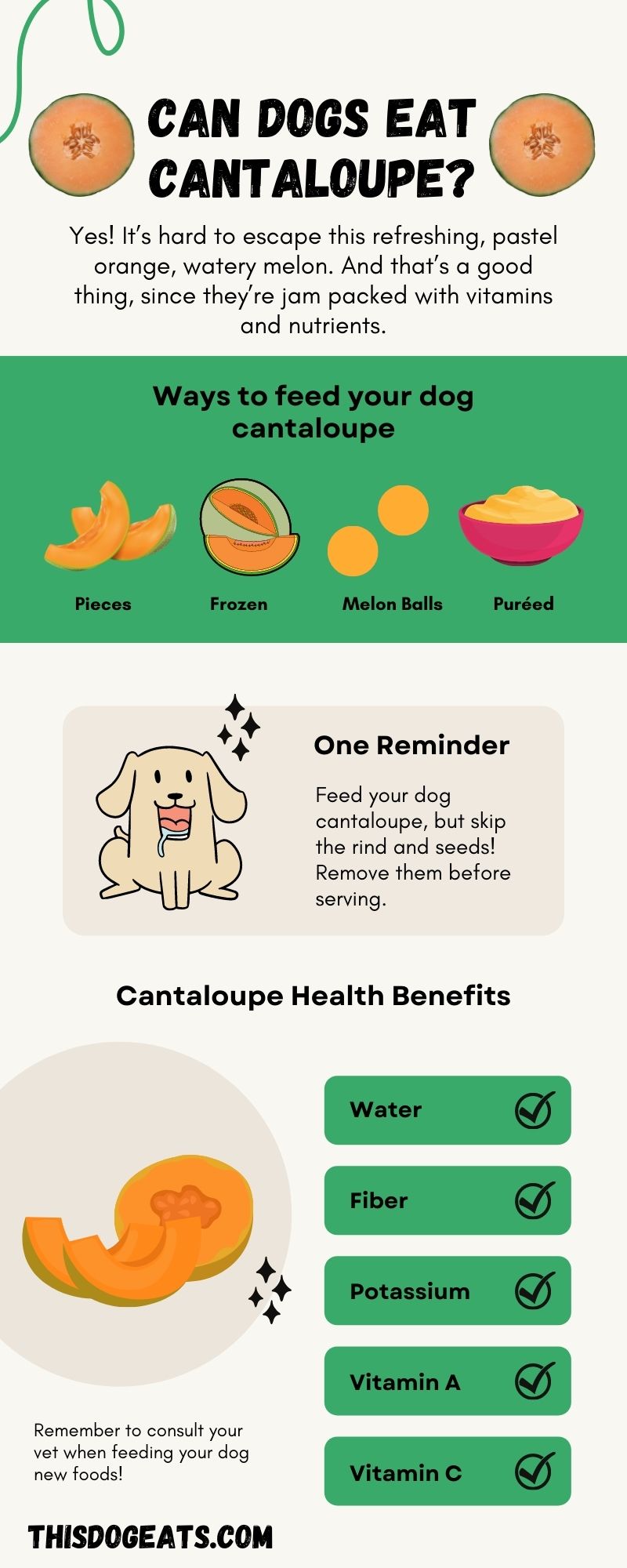Can dogs eat cantaloupe?
Come summer, sweet and juicy melons start to pop up all over the place. You’ll find fruit salads, popsicles, and smoothies bursting with melons of all sizes, and chances are you’ll spot one of our favorites: cantaloupe!
It’s hard to escape this refreshing, pastel orange, watery melon. And that’s a good thing, since similar to their cousins, the watermelon and the honeydew, they’re jam packed with vitamins and nutrients.
But while you chow down on cantaloupe, can your dog dig in too? Can this hydrating, fiber-filled treat be a summertime staple for your pup? Yes! Here’s what you should know about feeding cantaloupe to dogs.
Can dogs eat cantaloupe?
Yes, it’s ok for your dog to eat cantaloupe, as long as it’s in moderation. Plus, cantaloupe is a healthy alternative to traditional treats that are oftentimes loaded with chemicals and preservatives.
Just don’t feed them the rind. More on that later.
And an important heads up – always consult your vet before sharing any human foods with your dog. That includes cantaloupe!

Is Cantaloupe Good for Dogs?
Yes, cantaloupe is good for dogs!
Just like their fellow melons, watermelon and honeydew, cantaloupe offers many health benefits. It’s rich in fiber, has a high-water content and is bursting with nutrients. This tasty melon is low in calories, and makes a fantastic alternative to traditional treats!
Here’s some of the good stuff that you’ll find packed into our friend, the cantaloupe:
- Fiber: Cantaloupe is rich in fiber! Fiber promotes healthy bowel movements, colon health, and relieves your dog of constipation. It also aids in weight management.
- Water: Cantaloupe is about 90% water, making it great for hydration and healthy digestion.
- Vitamin A: Supports vision and skin health, and helps power the immune response.
- Vitamin B6: This vital coenzyme is responsible for glucose generation, red blood cell and nervous system function, and hormone regulation, among other things.
- Vitamin C: This antioxidant boosts your dog’s immune system, supports healthy aging, and reduces inflammation.
- Vitamin K: An essential vitamin that aids in blood clotting and coagulation.
- Antioxidants: Repairs cells damaged from environmental stresses put on our dogs’ bodies and supports brain health and the immune system.
- Potassium: Helps muscle development, supports healthy kidney and heart function, and aids in healthy bone density.
- Niacin: Helps to break down sugars and fats into energy.
- Magnesium: Promotes bone growth and helps the body produce protein and absorb vitamins.
- Folate: Also called folic acid, this is an essential mineral that supports normal metabolic functions such as DNA synthesis and red blood cell production.
How to Give Your Dog Cantaloupe Safely
Even though cantaloupe makes a great snack for your dog, there are still some risks associated with feeding it to your dog.
Cantaloupe rinds are tough, and they can be a choking hazard. If ingested, they can cause gastrointestinal upset and impact your dog’s digestive tract. Given their density, they can also be hard for your dog’s body to break down and pass. Be sure to remove the rinds when prepping the cantaloupe.
If your dog accidentally gets into the garbage and gobbles a bunch of discarded rinds, look out for diarrhea and vomiting and call your vet immediately.
Cantaloupe seeds are also indigestible and can cause an upset stomach. Scoop out the middle part of the cantaloupe, where the seeds are, and discard them.
For those cantaloupes that come with a bit of greenery attached, the leaves and vines of the cantaloupe plant are nontoxic, but still shouldn’t be ingested. Discard them as well.
Be sure to cut the cantaloupe into bite sized pieces appropriate for your dog, and feed them as treats in moderation. Cantaloupe is high in sugar, so too much cantaloupe is no good.
As with all new foods, speak to your vet before introducing cantaloupe to your dog’s diet.

How to Serve Cantaloupe to Your Dog
Always ask your veterinarian before adding something new to your dog’s diet. Most dogs won’t react negatively to cantaloupe, but it’s better to be safe than sorry.
Once you’ve gotten the green light, give your dog a very small amount of cantaloupe to start, and feed it to them slowly. Keep an eye on them and watch for any sort of reaction.
When preparing the cantaloupe, follow these steps:
- Wash and rinse the cantaloupe. Rinse the cantaloupe thoroughly to wash off any preservatives, pesticides, or dirt. This is especially important if your cantaloupe is not organic.
- Remove the rind and seeds. Don’t feed these pieces to your dog, compost them instead!
- Cut the cantaloupe into bite-sized pieces. Avoid the risk of choking by cutting the melon into small pieces.
Here are a few safe ways to feed your dog cantaloupe:
- In pieces: Cut the cantaloupe into bite sized pieces after removing the rind and seeds.
- Frozen: Remove the rind and seeds and freeze in a tupperware or ziploc bag. Great as a treat on a hot summer’s day!
- Purée: Remove the rind and seeds and purée the fresh cantaloupe. You can serve up as a melon smoothie, or freeze the purée in an ice cube tray.
- Melon balls: If you have a melon scooper, scoop the cantaloupe into small balls. They make great bite sized pieces and they’re great to toss in the air for your dog to catch.
- Dehydrated cantaloupe: Dehydrated cantaloupe makes a sweet and chewy fruit snack.

How Much Cantaloupe Can My Dog Eat?
When it comes to fruit, it’s not just what you feed your dog, but how much you feed your dog.
Vets often recommend that treats, including fruits like cantaloupe, make up only 10% of the calories in your dog’s diet.
Cantaloupe has a higher sugar content than other treats, so it should always be fed to your dog in moderation.
It’s also high in fiber, so too much of it can cause an upset stomach.
As always, speak to your vet before feeding your dog any new foods. They’ll be able to advise you on how much cantaloupe is too much.
Now that you’ve got the skinny on dogs and cantaloupe, check out other fruits your dog can eat.








